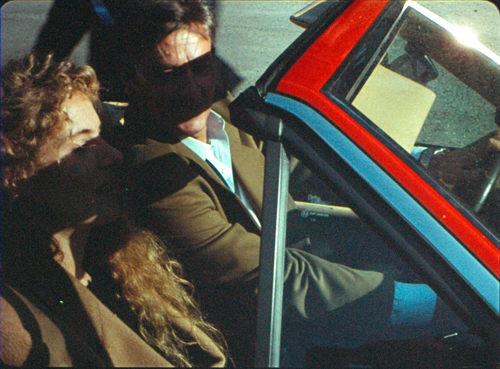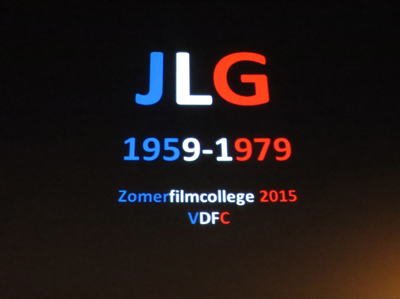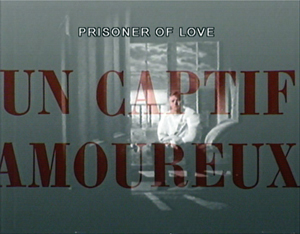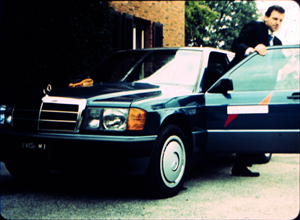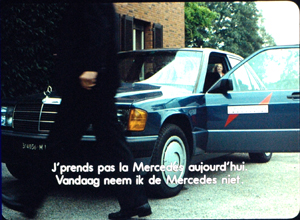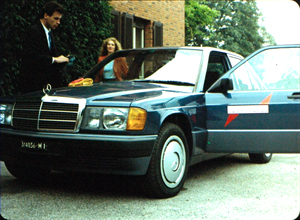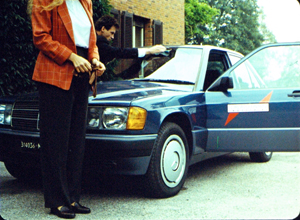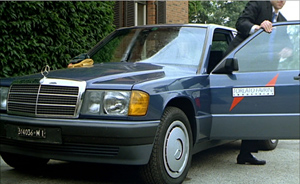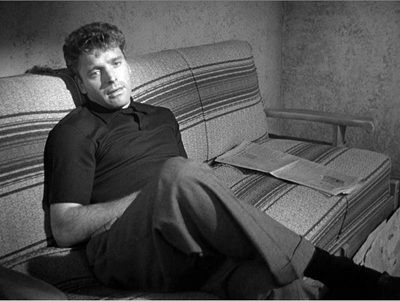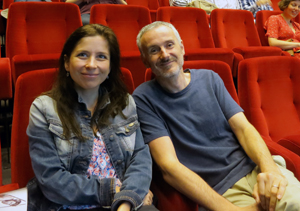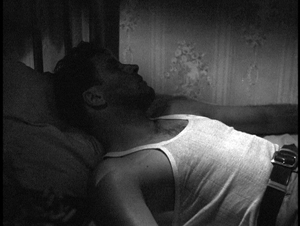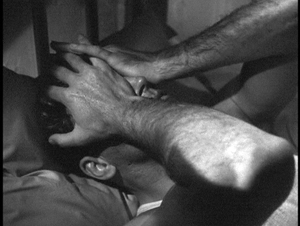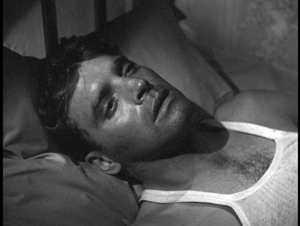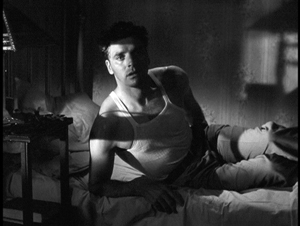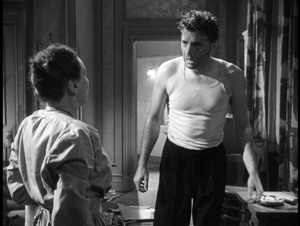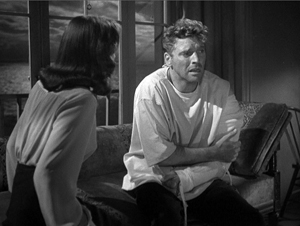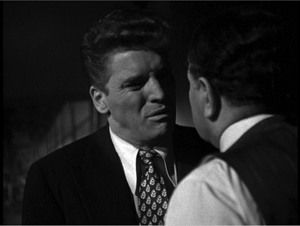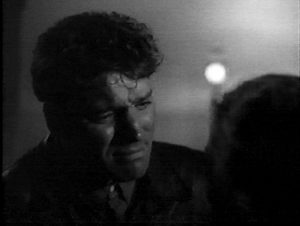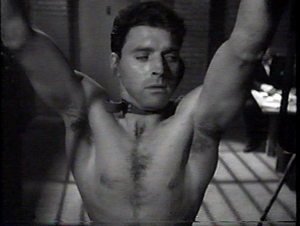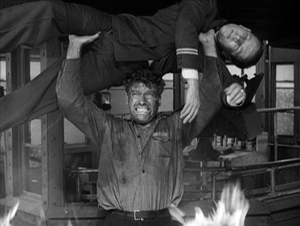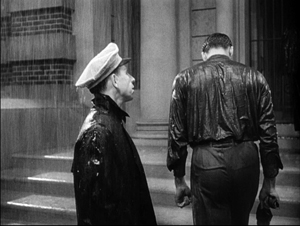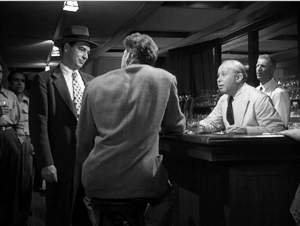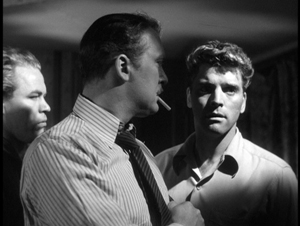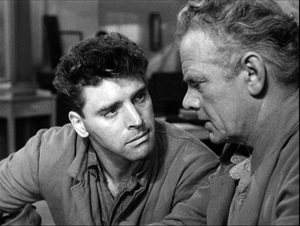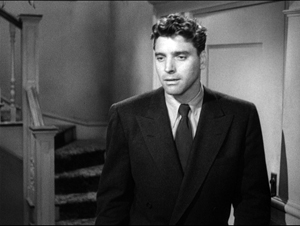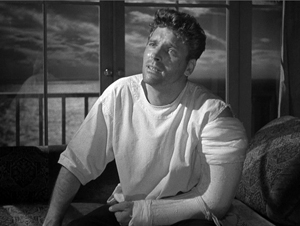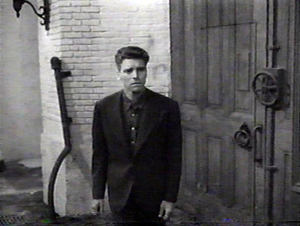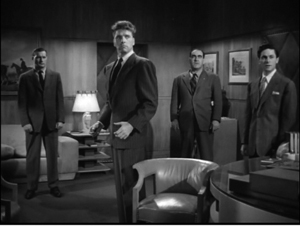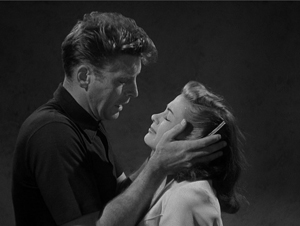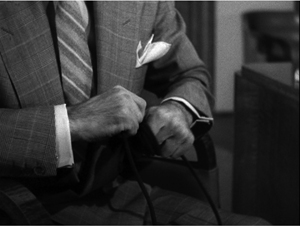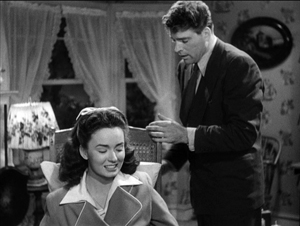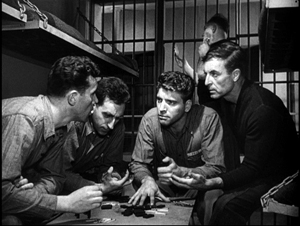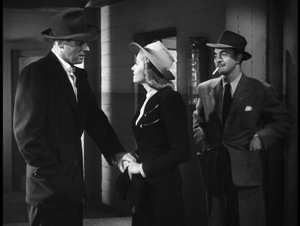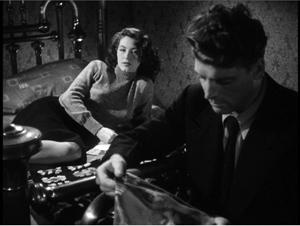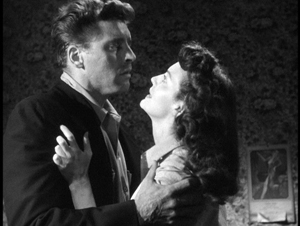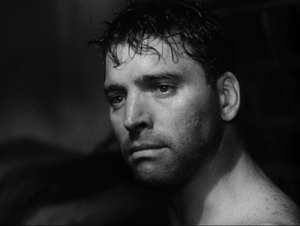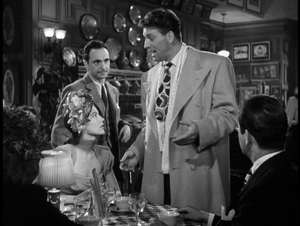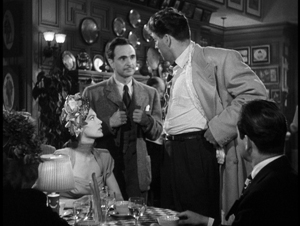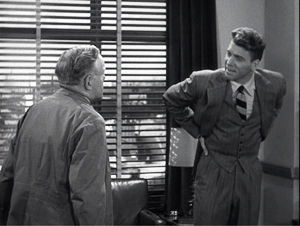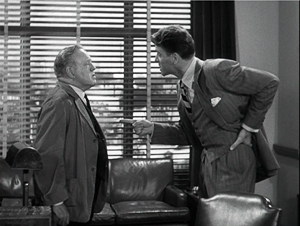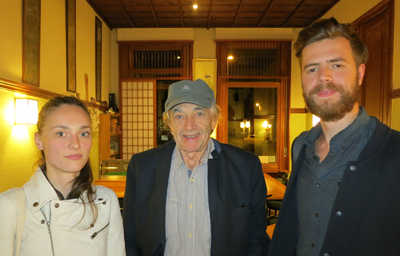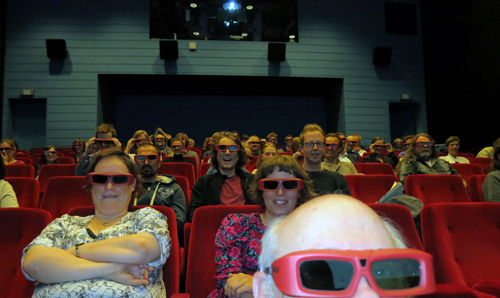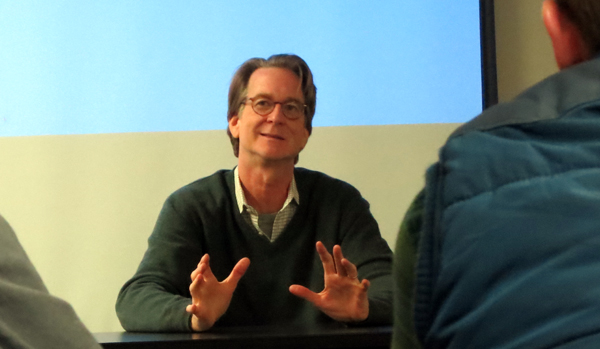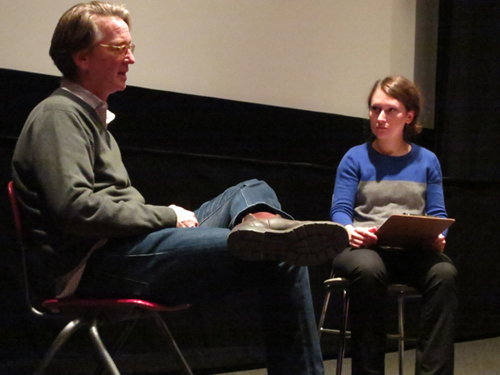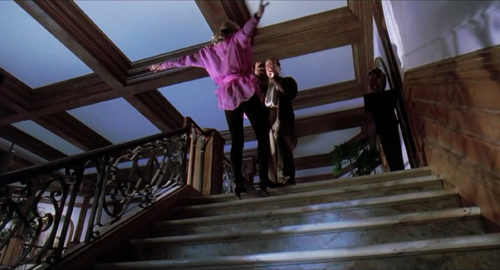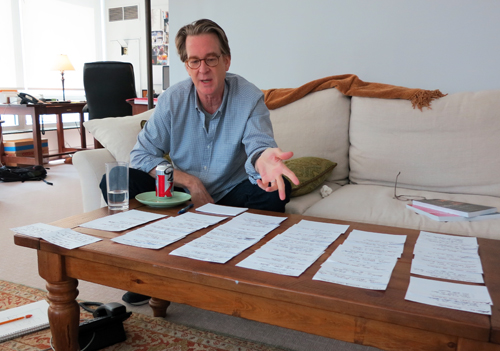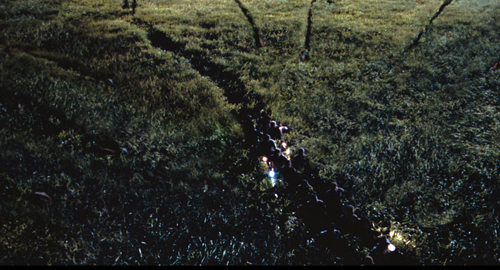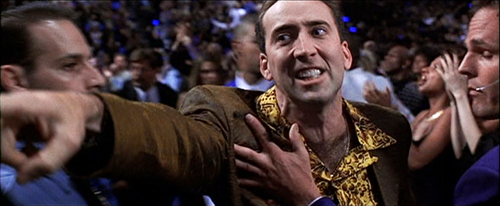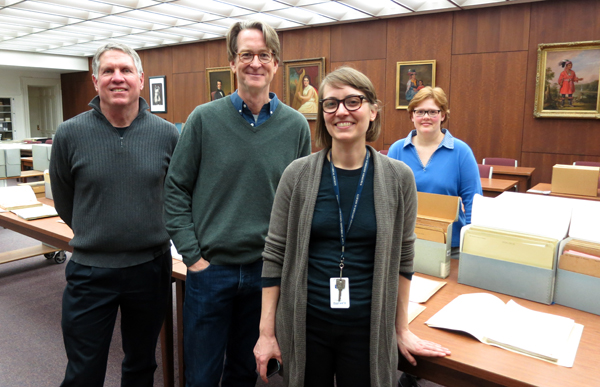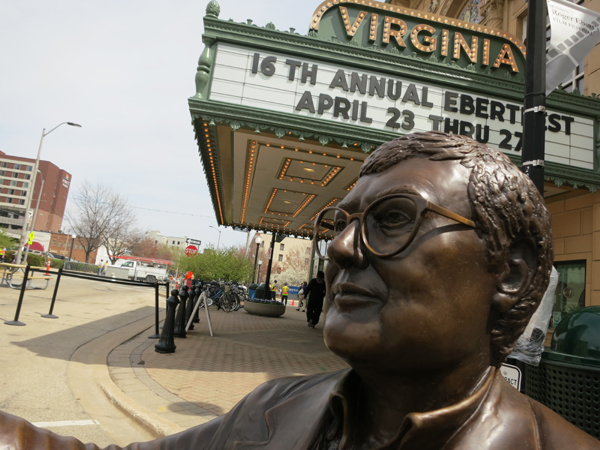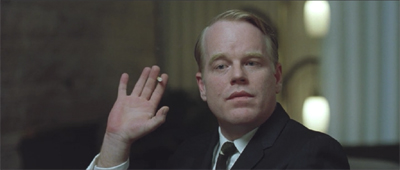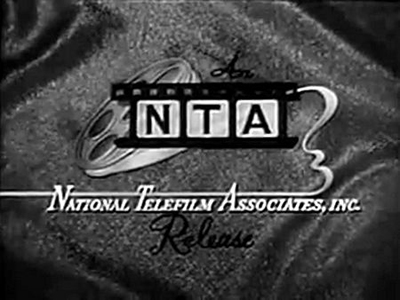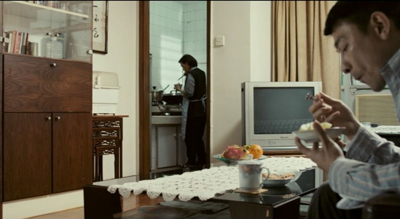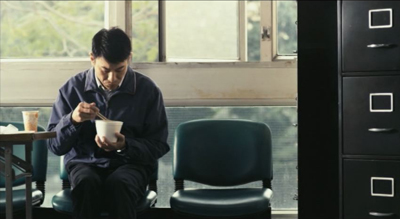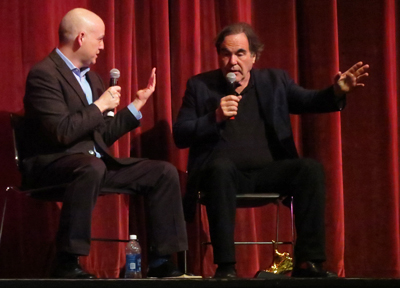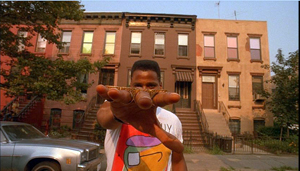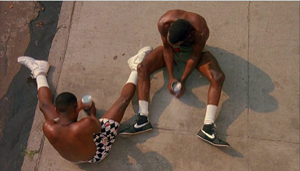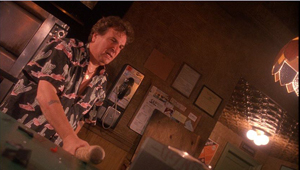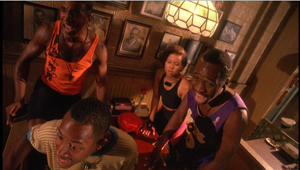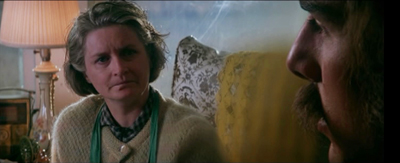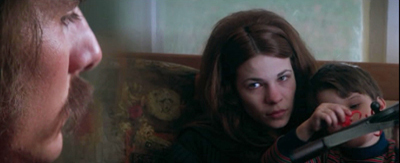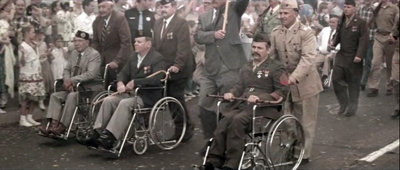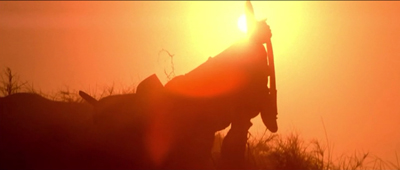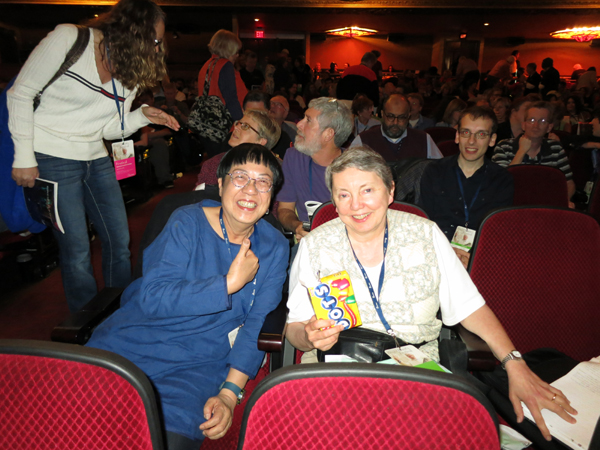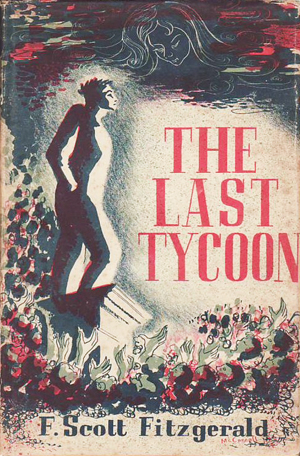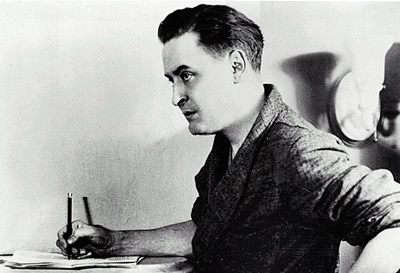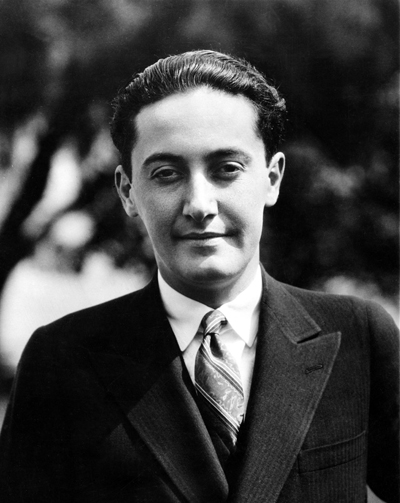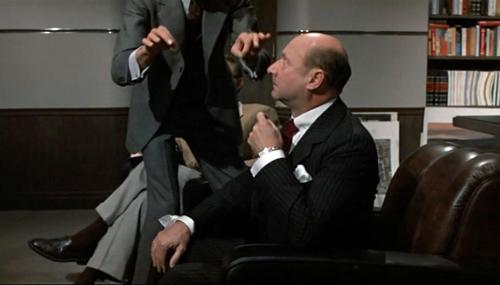Archive for the 'Hollywood: The business' Category
Watch those hands; or, Burt, Jean-Luc, and Bill come to Cinephile Summer Camp
Nouvelle Vague (1990).
DB here:
At this year’s Summer Film College in Antwerp, Peter Bosma pointed out that the event seems to be a unique mixture.
Films are screened from morn to midnight: this time, 38 films across 6 days and two half-days. But it’s not exactly a film festival, as there are no new releases.
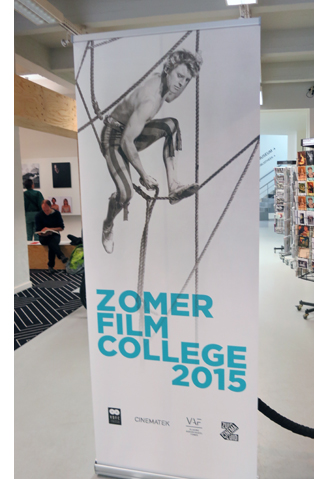 So is it like Bologna’s Cinema Ritrovato? Not exactly. While the shows included some restored titles (notably the Belgian Cinematek’s pretty makeover of Pollyanna, 1920), the films were mostly original prints with an occasional DCP.
So is it like Bologna’s Cinema Ritrovato? Not exactly. While the shows included some restored titles (notably the Belgian Cinematek’s pretty makeover of Pollyanna, 1920), the films were mostly original prints with an occasional DCP.
Moreover, the films cluster around two or three major themes. This year we had Late Godard (fourteen titles, counting episodes of Histoire(s) du cinema) and the career of Burt Lancaster (eleven). In addition, there were nightly showcases called “Masterworks in Context,” which included one surprise film, title undisclosed. But unike most movie marathons, the Summer Film College introduces screenings with lectures and discussions. This year there were fourteen sessions, each running about ninety minutes. These are serious, intensely informative talks—very far from the usual brief introductions one gets at festivals or in art house warm-ups.
So is it an educational enterprise? Definitely, but without assignments, tests, or grades. It’s designed to serve Flemish-speaking professors and students, but also civilians who are just interested in a weeklong package of film and film talk. The event helps forge a community of film appreciation.
Finally, there’s often a guest filmmaker on hand, usually related to the main threads. This time it was Bill Forsyth, who directed Burt in Local Hero. That film was screened, along with Bill’s wonderful Housekeeping.
So what would you call the College? I once called it Cinephile Summer Camp, and that still seems accurate in evoking the sense of fun and camaraderie that pervade the place. We don’t all get mosquito bites, but after a week you come to enjoy seeing familiar faces and talking with them about what they’re seeing. Just as when you go to summer camp, you get to stay up late. But at no summer camp I ever attended did we drink so much beer.
JLG/SJ/DB
The principal speakers were Tom Paulus and Anke Brouwers, who covered Burt, and Steven Jacobs on Late Godard. The Masterworks in Context shows were introduced by several guest speakers, including Lisa Colpaert (excellent on I Walked with a Zombie) and Vito Adriaensens (covering both Murder! and Vampyr). For Pollyanna, Bruno Mestdagh of the Cinematek staff explained the process of restoration. I played utility infielder, offering one talk on Burt and three on JLG.
How often do you get to see 35mm prints of Une femme mariée, Passion, Je vous salue Marie, Détective, JLG/JLG, Eloge de l’amour, and Nouvelle Vague? The Godard series, which ended with a 3D show of Adieu au langage, was a high point of my summer viewing. Back home I had prepared by rewatching all Godard’s features from Sauve qui peut (la vie) onward, but my video homework didn’t prepare me for the way the big screen amps up their prickly, seductive power.
I don’t speak or read Dutch, so I missed many subtleties in Steven Jacobs’ talks, but thanks to Power Point I could figure out the main points. Few lecturers can pack so much information and ideas into ninety minutes.
We had no way of knowing how familiar the audience was with Godard, early or middle or late, so Steven started with an orienting talk on JLG’s pre-1980 work (above). He swiftly reviewed key aspects of Godard’s New Wave period, traced his shift toward “a critical cinema” between 1967-1969, and explored the move into his Marxist phase. Along the way, he stressed the way cultural developments like auteur theory, Pop Art, Maoism, Brechtian theatre, and semiotics shaped Godard’s films. Particularly acute was his discussion of the “one image after another” sequence in Ici et ailleurs (1975). In all, the talk was an ideal prelude to Une femme mariée, which pointed up so many motifs of the later work: the focus on the couple, the emphasis on media-based images, and the persisting shadow of the Holocaust.
Steven is an art historian at University of Ghent; he earlier appeared on this blog as co-author of the imaginative book The Dark Galleries. After tracing Godard’s return to mainstream cinema and his move to Rolle, Switzerland, Steven focused on that splendid example of JLG the painter, Passion. Steven has written eloquently on the film in his Framing Pictures, and here he widened his focus to discuss its relation to other films centered on the tableau vivant, like Pasolini’s La Ricotta and Ruiz’s Hypothesis of the Stolen Painting.
You’d expect that Steven would have a field day with Histoire(s) du cinema, and he did. Unlike most Godardophiles, I’m not wild about this series of video essays. I can’t take them as serious studies in film history, and too often I sense he’s just playing around. (Enough with the stroboscopic flashes, okay?) But Steven obliged me to rethink them by showing how they fit into the Postmodern art scene, especially the video art movement after the 1970s. He pointed out the central importance of the Hitchcock episode and the series’ constant concern with the Holocaust, often in dialogue with Shoah. Citing Godard’s claim that video taught him to see cinema in a new way, Steven suggests that the format also created a tenor of paradoxical melancholy. It’s as if JLG’s experiments with this new technology drove him to celebrate the death of the cinema he knew.
My three talks on Late Godard tried to ask something that I didn’t find many traces of in the literature. What are these films doing with (or against) narrative? I think that the focus on JLG as “film essayist” has sometimes obscured the fact that he has long insisted that he needs stories. Yet he seems to have no interest in the craft of storytelling as we understand it. He avoids dense exposition, careful foreshadowing, well-timed revelations, and cumulative climaxes. He tends to spoil the narrative expectations he sets up.
As a result, his plots—for his films have them—are distressingly opaque. Exactly what happens in a Late JLG film is often difficult to determine. I’m always surprised when discussions of these late films provide capsule plot summaries, for the very difficulty of arriving at these should claim our attention. As just one instance, many critics seeing Adieu au langage for the first time thought the film centered on one couple. It centers on two. But the fact of that mistake ought to interest us enormously: What in the film’s presentation made it difficult to follow the basic situation? Are there strategies Godard follows in creating his apparently willful obscurity?
Godard’s unique strategies of storytelling are carried down into felicities of visual and verbal style. Again, I think that critics haven’t sufficiently acknowledged just how strange and opaque the surfaces of these movies are. For one thing, characters are unidentifiable from scene to scene, thanks to camera setups that cut off their faces, wrap them in shadow, or leave them offscreen altogether.
I’ve touched on these matters earlier (here and here), but just as a quick example, consider this shot from the opening of Nouvelle Vague. It has to be one of the most oblique introductions to a protagonist we can find in cinema.
Corporate owner Elena Torlato Favrini strides out of her mansion past her chauffeur while taking a transatlantic call. Any other director would favor us with a close view of her, perhaps tracking as she cuts a swath through her entourage. Instead we get a shot framing her chauffeur climbing out of their Mercedes.
As he crosses in front of the car, we hear her on her cellphone. She can be glimpsed fleetingly in the background, through the car window.
She approaches us, becoming briefly visible as she passes the car, but when she stops, she’s decapitated. We don’t get anything like a good look at her, and the locked-down camera refuses to reframe her. Instead, the framing emphasizes her slipping on her gloves.
The gesture ties into other imagery in the film. A little before this shot, there’s an isolated shot that establishes hands as a major motif in the film. But we should also notice that this fairly abstract shot also presents the gesture of Elena slipping on a glove. Or rather, it almost presents it, as the shot is abruptly chopped off just as the gesture begins.
So slipping on the glove, started in an earlier shot, is finished at the Mercedes. But just as important, the visual idea of a hand gesture broken by a cut resurfaces at the climax. When Richard Lennox helps Elena out of the water, the action is also incomplete. Only five frames show him grabbing her arm before a cut interrupts the action.
Another filmmaker would have held the image on that triumphant grip, but Godard denies us this little burst of satisfaction. Of the five frames in this bit of the shot, there is just one frame showing Richard’s hand seizing her. Godard again spoils a solid narrative effect. But he does narrative in his own way, with the broken-off gestures counterpointed by the hands that do meet at other points in the film.
Every scene in Nouvelle Vague, and most scenes in Late JLG, seem to me to be built on one or more fine-grained pictorial and auditory ideas like these. Those ideas can seem perverse, as in the chauffeur scene: why let us see his face but play down Elena’s? He’s not a major character; we don’t even learn his name until the film’s final moments. Unhappily, this peculiar instant of comparison is lessened in the 1.66 version of the film available on DVD. That image suppresses the driver’s face no less than Elena’s, losing Godard’s peculiar version of “gradation of emphasis.”
All the more reason to try to see these films in their full-frame glory, as I’ve argued before.
BL (Beautiful Loser)/AB/TP
Criss Cross (1949).
With big tousled hair, unadulterated sinew, and teeth gleaming like a Pontiac grille, Burt Lancaster came to fame in the late 1940s. He belonged to a new cohort of actors quite different from the 1930s Debonairs (William Powell, Melvyn Douglas, Cary Grant) and the Bashful Boys (Cooper, Fonda, Stewart). Yet the new lads were also at variance with the rugged Ordinary Joes (Cagney, Bogart, Tracy, Gable).
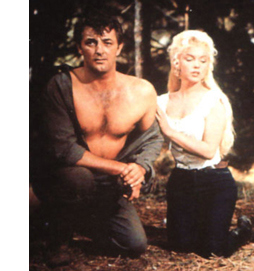 For one thing, Lancaster, Victor Mature, Robert Ryan, Robert Mitchum, Kirk Douglas, and Charlton Heston were brawny—monsters, in a way. They often took off their shirts. One publicity still for River of No Return shows Mitchum more unclothed than Monroe. Three of them played prizefighters, and Mitchum, himself a boxer, had the broken nose of a brawler.
For one thing, Lancaster, Victor Mature, Robert Ryan, Robert Mitchum, Kirk Douglas, and Charlton Heston were brawny—monsters, in a way. They often took off their shirts. One publicity still for River of No Return shows Mitchum more unclothed than Monroe. Three of them played prizefighters, and Mitchum, himself a boxer, had the broken nose of a brawler.
Of the group, Burt had probably the strongest A-list career overall. He fostered a great variety of projects. Who else of his generation appeared in films by Visconti and Malle? What other unflinching liberal was prepared to play a US general bent on a coup (Seven Days in May) or a conspirator behind the Kennedy assassination (Executive Action) or an obstinate officer fighting in Vietnam (Go Tell the Spartans)? He portrayed a renegade officer demanding the revelation of the brutal policy behind the Vietnam War (Twilight’s Last Gleaming). His closest rival and frequent costar Kirk Douglas didn’t enjoy such a vigorous and prestigious twilight. Only Brando kept beating him to the prize: Burt wanted to play the lead in Streetcar Named Desire and The Godfather. Unpredictably, he wanted as well to play the gay prisoner in Kiss of the Spider Woman.
I had had only slight interest in Burt as a star before this edition of the Summer School. But listening to the talks, seeing the films, and preparing my contribution made me realize how extraordinary an actor he was, and how important in Hollywood postwar history. Burt was well-served by the fine lectures offered by Tom Paulus and Anke Brouwers.
Anke provided an in-depth survey of how Burt and the Brawny Gang brought to a new level the culture of male athleticism—on display in Fairbanks and Valentino, developed further in the body-building craze of the 1930s, and culminating in what one 1954 magazine article called Hollywood’s “Age of the Chest.” She brought in forgotten pin-up boys like Guy Madison and pointed out how Burt and his peers paved the way for Rock Hudson and Tony Curtis. Anke went on to specify Burt’s beefcake persona, established in The Flame and the Arrow (1950) and locked into place in The Crimson Pirate (1952), which we saw. In her followup talk next day, she surveyed Burt’s place in the industry. He was one of the few stars to supervise a successful independent production company, Hecht Hill Lancaster (earlier, Norma Productions and Hecht Lancaster).
Tom moved on to consider Burt’s star charisma. He traced how Burt adjusted his authoritative image to different roles—the con man, the confident leader, the embittered idealist. Tom was especially good at analyzing Burt’s acting technique, tying it to particular trends in theatre and film of the time and pointing up the physicality of his performance of specific, precise tasks. Given the standard situation of rigging a bomb, he contrasted Burt’s meticulous finger work in The Train (1964) with that of Kirk going through the motions in The Heroes of Telemark. Tom even spared some time for Burt’s diction—a quality that really popped out when we watched Elmer Gantry (1960).
In a later lecture, Tom surveyed “Late Burt,” and his relation to political cinema of the 1960s and 1970s. He followed that with a revealing account of Burt’s relation to the trend of “Mexican Westerns” launched in the 1950s. Another arc in Burt’s career: from Vera Cruz (1954) to Ulzana’s Raid (1972), with The Professionals (1966) in between. That we saw in another gorgeous print.
I could go on a lot more about Tom and Anke’s lectures, but I don’t want to give away too much. The talks contained so much original research and discerning analysis of both the films and trends within film history that I’m hoping Tom and Anke will lay these ideas out at book length. Part “star study,” part film criticism, part industry history, their lectures were exhilarating.
My own contribution was minimal, a talk on First-Phase Burt. The Brawny guys were well-suited to the trend toward hard-boiled movies, those crime pictures we later decided to call “noirs.” Those weren’t usually suitable for older players (though there were some makeovers, such as Dick Powell and Fred MacMurray). To fill these roles came Alan Ladd, Glenn Ford, Dana Andrews, and Richard Widmark, along with the beefcakes. At the same time, “independent” producers within the studios began contracting their own new talent and loaning it out. Burt was signed by Hal Wallis at Paramount, who also had Kirk Douglas, Wendell Corey, and Lizabeth Scott in his stable. Films like Desert Fury (1947) and Sorry, Wrong Number (1948) were Wallis package projects.
Hired straight from the stage with no film experience, Burt debuted as the Swede in The Killers (1946), on loanout to Mark Hellinger at Universal International. Burt benefited from a galvanizing entrance. Lying on a bed in the dark, refusing to flee the hitmen on his trail, Burt is a shadowed, curiously languid torso in a tight undershirt.
Only after a beat do we see something else: massive hands rubbing a weary head. Soon that head is revealed.
As the killers burst in, the whole image comes together.
Has a Hollywood beginner ever been given such a gift as this opening?
With this onscreen wattage, it’s all the more striking that this young discovery is curiously absent from his early films. He’s onscreen for only a third of The Killers’ running time, and not even half of Brute Force (1947) and Sorry, Wrong Number. The film Wallis wanted to be his debut, Desert Fury (1947), gives him only twenty-three minutes out of ninety, and in the second male lead at that. All My Sons (1948) puts him in an ensemble drama. I Walk Alone (1948), the Norma production Kiss the Blood Off My Hands (1948), and another Universal project, Criss Cross (1949) start to make him a proper, central protagonist. By then, he is ready to become the star attraction of the swashbuckling films.
Moreover, in his early phase, he mostly plays losers. Not the brightest guy in the room, he’s easily suckered by a femme fatale in The Killers and Criss Cross. He makes amateurish mistakes at crime (Sorry, Wrong Number) and, coming out of prison, he is the last to realize the rackets have gone corporate (I Walk Alone). At the start of Kiss the Blood he punches a man too hard and kills him. He’s caught and whipped and imprisoned, and when he comes out he stumbles back into crime again. He’s shrewd enough to set up a prison break in Brute Force, but so doggedly determined is he to reunite with his girl on the outside that he launches a suicidal bloodbath.
When he finally catches on to his fate, we get expressions ranging from stupefaction to anguish (The Killers, Criss Cross).
He even cries (All My Sons, Kiss the Blood).
Loser or winner, when he is onscreen, he has the outlandish physical presence of the born star. Most obvious is a physique (Kiss the Blood, Brute Force).
Even his back, featured with a prominence we get with few other actors, is straining against a drenched prison uniform (Brute Force) or a tailored suit (Criss Cross).
The face was a cameraman’s dream; it could be craggy or somber, thoughtful or tormented (The Killers, Brute Force x2, Criss Cross).
He can be stiff-armed and zombielike coming out of prison in Kiss the Blood, but he can also gamely cock his elbows, ready to spring, like Cagney and Cary Grant (I Walk Alone).
The enormous hands, which look likely to crush a skull (Criss Cross) or rip apart a phone cord (Sorry, Wrong Number), could be surprisingly delicate, tentatively touching his girlfriend’s wheelchair or laying down plans like playing cards (Brute Force).
In The Killers he makes skillful use of those hands, pocketing his busted one or spreading out the scarf given him by the treacherous Kitty.
Easily taken in by Kitty’s plan, he seems to have a qualm when his gripping embrace relaxes and the fingers splay in hesitation.
This sort of handwork would become crucial, as Tom pointed out, to Burt’s performance style, particularly in The Birdman of Alcatraz.
“I’d never looked in eyes as chilling as Lancaster’s,” Norman Mailer once said. You can see what he meant.
Again, though, the actor is in control. Some years back I wrote that eyes by themselves aren’t very expressive: the eyelids, eyebrows, and mouth tell us more. I still think that’s right, but Burt manages to convey the sense of the beast at bay with remarkable control of just the eyeballs. He seems to be looking for an escape hatch without moving his head an inch.
While Burt was playing losers, his counterpart Kirk Douglas was often playing heels—cynical manipulators who stomp on everybody else, as in I Walk Alone. Sometimes Kirk learns his errors (Young Man with a Horn, 1950) but several roles of the period, in Out of the Past, Champion, and Ace in the Hole, make him a glib villain or tawdry antihero. Somewhat later Burt explored this characterization too, notably in Vera Cruz, Elmer Gantry, and The Rainmaker (1956). How did he shift from the beautiful loser to the fast-talking con artist?
I think there are hints from the start. In The Killers, after he’s washed up as a fighter, the Swede goes in for street crime. When he confronts his old friend the cop, Lancaster brings those arms and hands into play. In his enormous unstructured topcoat, he lifts his fists up to his waist. It’s both the businessman’s getting-down-to-brass-tacks sweep, but also a kind of puffing up, exposing that massive frontal expanse. Little Sam Levene can grasp his lapels, but he doesn’t stand a chance against this.
Burt uses the same imperious gesture when, in Sorry, Wrong Number, he’s trying to bully a company employee into joining a crooked deal.
In these noir movies, his intimidation of others won’t put him ahead of the game. But perhaps these arm movements begin to sketch a more flamboyant loser like Gantry. By striking what actors used to call an “attitude,” Burt could start to build an entire character: a hell-for-leather charlatan.
Seeing the films, listening to Tom and Anke, and studying Lancaster’s work on my own brought home to me again the importance of the details of performance and the presence of a star. These movies would be utterly different if Mitchum or William Holden played the Burt parts. Our actors don’t wear masks or Hazmat suits. We’re powerfully affected by what they bring to the character in voice, body, face, and gesture—the expressive dimensions of cinematic presence.
BL/JLG/BF
College coordinators Lisa Colpaert and Bart Versteirt, flanking Bill Forsyth.
What do Burt and JLG have in common? For one thing, some images from Criss Cross in Histoire(s) du cinema 1a (see above). For another, Bill Forsyth.
With the success of Gregory’s Girl (1981), Bill was invited by David Puttnam, then at Columbia, to make a Scottish movie with a couple of American actors. The result, Bill says, now looks to be a “soft-core environmental movie.” Local Hero (1983) remains much loved, and for good reason. It makes nearly all of today’s multiplex raunch look adolescent. It has a tone of civility, an embrace of eccentricity, and a genuine interest in people reminiscent of Ealing comedies. For me it’s a masterpiece of sweet, light-hearted art.
Local Hero feels loose and leisurely, but it’s actually a very economical movie. The first few minutes should be studied by screenwriters interested in tight exposition and fast attachment to a protagonist. It’s peppered with sidelights on its central drama, such as the Russian’s song about how “even the Lone Star State gets lonesome.” That neatly sums up the situation of the yuppie sad sack MacIntyre (“I’m more of a Telex man”) learning about village life. As usual, I was moved by Mark Knopfler’s plangent score, the electronic overtones meshing with the pulsations of the Northern Lights.
Burt’s role is that of CEO deus ex machina. Having assigned Mac to buy a Scottish seacoast town for an oil refinery, Mr. Happer eventually descends in his chopper and decides to establish a laboratory there instead. Burt’s crisp delivery and tight fingerwork are still on display at age seventy. The other actors don’t use their hands as much as he does–partly so they’re not distracting us from him, I suspect, but also because newer-style Hollywood acting doesn’t encourage it. In any case, as usual Burt uses his acrobat’s sense of physicality to intensify his performance. Even clasping his hands behind his back tells about the character’s authoritative dignity.
Bill learned that Burt regretted not doing more comedy, so he wrote the mogul’s part with him in mind. Burt signed on eagerly. He showed up on the set with a full beard, hoping Bill would let him keep it; they compromised on a mustache.
Bill had worked mainly with teenage actors on That Sinking Feeling (1979) and Gregory’s Girl, so Burt was really the first adult performer he ever directed. Across their three weeks together, Burt demanded nothing, except that he wanted to loop his dialogue. Bill preferred not to loop, and as it turned out only one scene needed to be rerecorded.
Burt and Bill skipped lunch in order to prepare the next scene, becoming “lunch bums.” Bill remembers Burt hanging out with the other actors and chatting with extras. He freely made fun of Bill’s accent: “”He speaks no known language.” He told Bill: “I don’t know what you’re saying, but I know what you mean.”
Bill talked as well about his own career. Starting out in the days before home video, he learned dialogue and pacing by audio taping classic films. (Sounds like a good idea to me.) He became a performer’s director. “The only thing I’ve ever said to a cameraman is: ‘Accommodate the actors.” He quoted Burt approvingly: “The space in front of the camera is the actor’s space.”
What’s the connection to JLG? It turns out that Godard was the director Bill most admired in his salad days. During the 60s he sated himself on art cinema, especially New Wave imports. When he saw Pierrot le fou, he left the theatre stunned. Godard became “the master. He still is, for me.”
Accordingly, Bill’s earliest cinema efforts were in an avant-garde vein. One piece, puckishly called Film Language, started with ten minutes of black leader while a text by Beckett was read out. Another, Waterloo, included a vast ten-minute shot in which the camera left one household, climbed into a car, rode a great distance, and ended up in another home. The film played at the Edinburgh film festival to an audience of 200. By the end three viewers were left. “I’d moved my first audience.”
Bill remarked that he sometimes regrets not sticking with experimental media. Today, he says, he might be a video-installation artist. A teasing idea. But we should be grateful that we got his features. I don’t know if Jean-Luc would agree, but I bet Burt would.
Thanks to Bart Versteirt, Lisa Colpaert, and their colleagues for a great week. Thanks as well to the participants, whose willingness to take on anything we threw at them was very encouraging. And a farewell to two friends who have projected films at every Summer Film College I’ve attended over the last sixteen years: Esther Dijkstra and Joost De Keijser. They have helped make the event the splendid enterprise it is.
Peter Bosma’s informative book Film Programming: Curating for Cinemas, Festivals, Archives is available here.
A detailed “index of references” for Histoire(s) du cinema is provided by Céline Scemama.
Our first encounter with Bill Forsyth was at Ebertfest. For more on actors’ handiwork, try this entry.
An eager crowd of campers awaits Adieu au langage.
The compleat screenwriter: David Koepp gives notes
DB here:
Regular visitors will know of my interest in David Koepp, screenwriter (Jurassic Park, War of the Worlds) and director (Ghost Town, Premium Rush). In 2013 I wrote an entry based on a long interview he kindly gave me.
Back in March of this year, David visited UW—Madison. It’s not strictly his alma mater; he left us to finish up at UCLA. Still, he retains ties to Wisconsin and recalls that while he was here he was inspired by our vast film society scene and some courses in the film and theatre departments. Across 2 ½ days he shared his experiences in a variety of settings, including Q & A’s after screenings of War of the Worlds, The Paper, and Ghost Town.
David is a craftsman who thinks about what he does. I’d call him an intellectual screenwriter if I didn’t think that made him sound more cerebral and austere than he actually is. He’s a vivacious, articulate presence: a born teacher, endowed with wit and good humor. During his visit he threw out plenty of ideas. Some are valuable for aspiring screenwriters, and others are intriguing guides for those of us who study movies.
Career paths
David Koepp and Maria Belodubrovskaya, 12 March 2015.
Starting out: If you want to write screenplays, a post at an agency isn’t ideal. It will, though, help you if you want to become a producer. Likewise, writing coverage can sensitize you to story, but it’s usually not the best route to becoming a screenwriter. It is a good path to becoming a creative executive.
Try to find a job that lets you write every day. A physically exhausting job makes you want to come home and zone out at night, when you should be writing.
Working from models: David learned a great deal from Kasdan’s Body Heat script. He recommends reading the first page of Hemingway’s novel To Have and to Have Not for a strong example of how character and story can co-exist and both start with strength and urgency.
David also urges writers to study plays, especially modern works by Tennessee Williams and Arthur Miller. [In the discussion, I failed to sell Chekhov as an alternative.]
Prepare for ups and downs, no matter how far you advance. Failure can encourage you to quit, but failure is endemic to the job and must be confronted the way an athlete learns to deal with injury. You must be resilient. “It’s dealing with failure that defines you as a person.”
Creative failures are, oddly, easier to handle if you’re directing because then the decision was yours. You understand how and why the mistakes were made. It’s harder to live with when you feel your script was in perfectly good shape and a director screwed it up or failed to express it clearly.
Maintaining a career
Death Becomes Her (1992).
“The first responsibility of an artist is to pay your rent.”
“Your ideas are your currency.” Talking about your script too much is a mistake. Keep your ideas to yourself as long as you can; otherwise you lose the need to write the script.
The time to talk is at the pitch meeting. It’s a bit disagreeable, but it forces you to have a clear-cut plot. “Until you tell it, you probably don’t have meaningful command of it.” Practice once or twice with a friend before the pitch, but not so many times that it becomes rote.
“Everything after the word no is white noise.”
Your first collaborator is the producer. Take seriously the problems he or she points out, but don’t automatically accept the solutions offered. Other voices are there to raise questions and point out problems, but not to solve them. Don’t let them take that job away from you; you’ll lose your voice.
The trick is to get your vision into the screenplay so that the director and the producer see it as you do. A good script is “all about clarity.” You can’t include camera directions, but every page should have a strong, simple image, briefly expressed. For example, in Death Becomes Her, Meryl Streep is teetering at the top of the stairs, before her husband pushes her down them. The script says: “She hovers there, like Wile E. Coyote at the top of a cliff.” It wasn’t a camera direction, but it called up a certain style in the mind of the reader, and, eventually, the director.
Read your dialogue out loud, playing all the parts.
Be prepared to have to write some things by committee, but, again, listen to the problems pointed out and think about the suggestions. But never let them fix your problems or take command of your story for you. It will lose its distinctiveness. The adage is: “No one of us is as dumb as all of us.”
The creative process
“Appeasing the audience gods”: Who will want to see your story?
The writer’s trance: “You get lost in it if it’s going well.” Play music, especially soundtracks to movies with a similar feel.
David’s steps:
*Thinking: “collecting string,” coming up with ideas on your own.
*Research: reading, interviewing, going on site. For The Paper, David and his brother visited a newsroom and got stories from journalists.
*Outlining: 3 x 5 note cards consisting of the obligatory scenes (“small, unintimidating chunks of story”). The cards can be arranged into five or so columns, corresponding to beginning, middle, and end. The card array gets turned into a prose outline (10-25 pages), with dialogue. “This is the heavy lifting.” At this point, the cards have served their purpose and you probably don’t return to them.
*First draft: Basically, something you can revise from. Those revisions should be successively shorter, so the story is never obscured by excessive description, no matter how well-written. “Scripts are not about pretty writing.” Be ready to cut. “You need less than you think you do.”
The 3-act structure is like musical scales, “something you can embrace or something you can rebel against.” But without some sort of structural approach, “it is all forest, no trees.”
Hollywood rewards success, but it also expects repetition of success. Your job is to try to do something different as frequently as possible. “I tried to write in every genre that interests me.”
Over twenty-seven years, David wrote about thirty scripts. Of them, roughly two dozen got made. Of that number, nine were originals. The most successful original was Panic Room, which was born from two ideas: the popularity of “safe rooms” in urban mansions, and the claustrophobia he once experienced when trapped in a small domestic elevator in a Manhattan townhouse.
Adapting a novel: In adapting, he first writes up an outline of the book itself, as written, to internalize its its structure, before creating the movie’s structure. Don’t worry about imitating the prose texture, especially passages presenting mental states. Film is about images and sounds, visible behavior and speech. But you can be faithful to the spirit of the novel. The War of the Worlds, though an update, respects Wells’ ideas and characterization.
Don’t pass up chances to use your craft; any job can be fun. Some assignments are painting, some are carpentry.
Rewrites may be imposed by studio staff or stars (who often push for a better or bigger role). You have to fight your way through them, taking what can help and talking your way out of ideas that can hurt. “Everything is a negotiation.”
In the shooting phase, the writer is often in a black hole, with nothing much to do. You needn’t be on the set, but do have to stay available if something needs to be done.
Studying film
The Lost World: Jurassic Park (1997).
What would David study if he were an academic? “I’d love to take a course that traces influences, such as the connection between Shaw Brothers and Tarantino. In other words, get away from traditional categories of genre and national cinemas and focus on conections of thought and style between apparently diverse filmmakers.”
Would he focus on directors rather than screenwriters? Yes, because the director is “the overriding creative force.” Today a screenwriter needs a director’s support to get a film done. Moreover, directors “have a degree of control you can’t imagine.” They shape performances, tone, imagery, and sound, and they often govern script rewrites. David was struck seeing You Can’t Take It with You on stage and then noticing how Capra’s film version made the play’s amiable patriarch into a capitalist villain–a characteristic Capra touch.
Accordingly, major directors like Fincher become obstinate about details. “You have to be belligerent. There’s no other way.” David was present when Spielberg couldn’t get the overhead shot he wanted in The Lost World: Jurassic Park. The plan was to frame raptors rushing through tall grass from above, so that all we see are trails converging on the fleeing people. But on the first visit to the location, the grass wasn’t tall enough. “If I don’t have the grass,” said Spielberg, “I don’t have a shot.” Tall grass had to be replanted and the shot taken later. [DB: I think that shot is borrowed, somewhat clumsily, in the Wachowskis’ Jupiter Ascending.]
Producers also can control the process. Accordingly, David would also study ones with strong identities like William Castle and Sam Spiegel.
David’s affinity is for classic Hollywood. As a kid watching on TV, he liked horror films and Sherlock Holmes movies. He likes modern films in the classic tradition. When he was 14 he saw Star Wars soon after Jaws, and these had strong impact on him. The only comparable phenomenon today, he thinks, is the Lord of the Rings trilogy.
On noir, especially Snake Eyes
Snake Eyes (1998).
What made him write so many noirish thrillers? Probably his childhood; your tastes are formed between 14 and 24. He experienced the darkness and paranoia of the 1970s, intensified by the fact of his parents divorcing. An important influence was Rosemary’s Baby as well, a film he still reveres.
Filmmakers love noir, but don’t describe your project as a noir. Studios hate the term. They believe it doesn’t sell. Panic Room isn’t a noir, the producers were told; it’s like “an Ashley Judd movie.” [Presumably before that became a problematic term too.—DB]
The morality of noir is tricky. You can have unsympathetic protagonists, but be careful handling the bag-of-money movie. You can’t reward greed. “You can’t get away with the money.” In The Killing, the money has to blow away. True Romance was less powerful, ending with the kids on the beach dancing and rich. This concern isn’t mainly about morality, just an ending that satisfies.
David wrote Carlito’s Way as a 30s Warners gangster film, with a characteristic downbeat ending. Hence the need to lead the audience to expect a dying fall: A flashback and the voice of a “nearly-beyond-the-grave narrator.” The whole movie takes place in an instant.
In Snake Eyes, David welcomed the noirish formal problem of telling the same story three times, as in Rashomon. The tripled presentation would have occupied Act 2. What about the optical POV switches? Typically, shots aren’t fully scripted, and they weren’t here: the POV angles were De Palma’s choice.
Originally the film had a classic noir flashback structure. The opening would show flood waters after the storm, with floating chips, playing cards, and a blackjack table. Then the main story would take us into the past. The climax, back in the present, was to have been a fight in the water with Sinese trying to drown Cage.
As for giving away a key element midway through: David thought it would work. (Hitchcock did it in Vertigo.) But audiences didn’t like it. They seem to feel uncomfortable knowing something big that the main character doesn’t. But what about a movie like Ransom, which also reveals the villain? Not such a problem, says David, because if you show a character lying, you should do so quickly—not hold off for many scenes and reveal it a fair distance from the climax.
“This is the fun part of storytelling: What do we tell ‘em, and when?” [DB: In Film Art, we put it this way: “Who knows what when?”]
Envoi
What about the writers’ tasks in the late phases of preproduction? As I was finishing this entry, David sent a dispatch from Inferno, Ron Howard’s latest Dan Brown adaptation. After moving from Budapest to Florence to Venice, the production starts shooting tomorrow. David writes:
David Koepp visiting the Wisconsin Center for Film and Theater Research, with Vance Kepley, Director; Amy Sloper, Head Film Archivist; and Mary Huelsbeck, Assistant Director.
Unveiling Ebertfest 2014
Kristin here:
In the early days of Ebertfest, Roger personally introduced every film at this five-day event, which took place this year from April 23 to 27. He would be onstage for the discussions and question sessions after each screening, often joined by directors, actors, or friends in the industry.
In the summer of 2006, there began the long battle with cancer that Roger fought so determinedly. He withdrew gradually from full participation in the festival that he had founded in his hometown of Champaign-Urbana sixteen years ago. He struggled to immerse himself in the festival, even though repeated surgeries had robbed him of his voice. He introduced fewer films, doing so with his computer’s artificial voice, and when even that became too taxing, he sat in his lounge chair at the back of the Virginia Theater, enjoying the event and occasionally appearing onstage with a cheery thumbs-up. Finally, last year on April 4, less than three weeks before the fifteenth Ebertfest, he passed away. That year’s festival became a celebration of his life.
The celebration continued this year, though on a more upbeat note. Some films were chosen from a list that Roger had left to his wife Chaz and festival organizer Nate Kohn, and they selected others in the same indie spirit. The tradition of showing a silent film with musical accompaniment was maintained. As always, the festival passes sold out, and the crowd, including many long-time regulars, enthusiastically cheered both films and filmmakers.
The tributes
Roger did not live to see the documentary devoted to his life and based on his popular memoir of the same name, Life Itself. It premiered in January at this year’s Sundance Film Festival. He participated in its making, however, encouraging director Steve James (whose 1994 documentary Hoop Dreams Roger had championed) to film him during the final four months of his life. Some of this candid footage reveals the painful and exhausting treatments Roger underwent, but much of it stresses his resilience and the support of Chaz and the rest of his family.
Life Itself was the opening night film. James has done a wonderful job of capturing the spirit of the book and in assembling archival footage and photographs, interspersed with new interviews. The result is anything but maudlin, with a candid treatment of Roger’s early struggles with alcoholism and an amusing summary of Roger’s prickly but affectionate relationship with his TV partner Gene Siskel.
Life Itself was picked up for theatrical distribution by Magnolia Pictures and will receive a summer release, followed by a showing on CNN. (Scott Foundas reviewed the film favorably for Variety, as did Todd McCarthy for The Hollywood Reporter.)
Another tribute followed the next day, when a life-size bronze statue of Roger by sculptor Rick Harney was unveiled outside the Virginia Theater (above). Harney portrays Roger in his most famous pose, sitting in a movie-theater seat and giving a thumbs-up gesture. There is an empty seat on either side of him, so that people can sit beside the statue and have their photos taken. (See the image of Barry C. Allen in the section “Of Paramount importance,” below.)
Far from silent
Roger was a big fan of the Alloy Orchestra, consisting of (L to R above) Terry Donahue, Ken Winokur, and Roger Miller, who specialize in accompanying silent films. They have appeared several times at Ebertfest, playing original music for such films as Metropolis and Underworld. Rather than taking a traditional approach to silent-film music, using piano, organ, or small chamber ensemble, they compose modern scores, played on electronic keyboard combined with their well-known “rack of junk” percussion section, including a variety of found objects, supplemented with musical saw, banjo, accordion, clarinet, and other instruments. The result is surprisingly unified and provides a rousingly appropriate accompaniment to the silents shown at Ebertfest over the years.
I have had the privilege of introducing the film and leading the post-film Q&A on some of these occasions, including for this year’s feature, Victor Seastrom’s 1924 classic, He Who Gets Slapped. (Swedish director Victor Sjöström used the Americanized version during his career in Hollywood.) I put the film in context by pointing out three important historical aspects of the film. First, it was the first film made from script to screen by the newly formed MGM studio, formed in 1924 from the merger of Goldwyn Productions, Metro, and Louis B. Mayer Pictures. (Two earlier releases by MGM were Norma Shearer vehicles which originated at Mayer.) Second, it was probably the film that cemented Lon Chaney’s stardom, after his breakthrough role as Quasimodo in the 1922 Hunchback of Notre Dame. Starting in 1912, Chaney had been in well over 100 films before Hunchback, many of them shorts and nearly all of them supporting roles. Third, He Who Gets Slapped was Seastrom’s second American film after Name the Man in 1923, and a distinct improvement on that first effort.
Naturally MGM wanted a big, prestigious hit for its first production, and He Who Gets Slapped came through, being both a critical and popular success–and also boosted Norma Shearer to major stardom. Seastrom and Chaney both stayed on at MGM, though the former returned to European filmmaking after the coming of sound and Chaney died in 1930.
I was joined for the post-film discussion by Michael Phillips of the Chicago Tribune, and we talked with Donahue and Winokur while Miller sold the group’s CDs and DVDs in the festival shop. They revealed that this new score had been commissioned by the Telluride Film Festival and that it was a project that appealed to their taste for off-beat films. There were many questions from the audience, and we suspect that the Alloy Orchestra will continue to be a regular feature of the festival.
A cornerstone of indie cinema
Although Roger was occasionally criticized for supposedly lowering the tone of film reviewing by participating in a television series, he and partner Gene Siskel regularly tried to promote indie and foreign films that didn’t get wide attention. Roger did the same in his written reviews, and Ebertfest was originally known as the “Overlooked Film Festival.” Inevitably it was shortened by many attendees to “Ebertfest,” and eventually that name became official. It reflects the wider range of films that came to be included, with the silent-film screening and frequent showings of 70mm prints of films like My Fair Lady that were hardly overlooked.
Among Roger’s friends was Michael Barker, co-founder and co-president of Sony Pictures Classics, one of the most important of the small number of American companies still specializing in independent and foreign releases. A long-time Ebertfest regular, Barker usually brings a current or recent release to show, along with filmmakers or actors. This year he was doubly generous, bringing Capote (2005, above), to which Roger had given a four-star review, and the current release Wadjda (2012).
Roger never reviewed the latter, but it is certainly the sort of film that he loved: a glimpse into a little-known culture by a first-time filmmaker with a progressive viewpoint. Wadjda is remarkable as the first feature film made in Saudi Arabia, where there are no movie theaters. Moreover, it was made by a woman, Haifaa Al-Monsour, and tells the story of a little girl who defies tradition by aspiring to buy and ride a bicycle in a country where this, like women driving cars, was illegal. (Below, Wadjda learns to ride a bicycle on a rooftop, hidden from public view.)
Both the film and Al-Monsour thoroughly charmed the audience. Barker interviewed her afterward, and she revealed that, not surprisingly, the making of the film was touched by the same sort of repression that it portrays. Women are not allowed to work alongside men in Saudi Arabia, so Al-Monsour had to hide in a van while shooting on location. Given that there is no cinema infrastructure in the country, the film was a Saudi Arabian-German co-production, with Arabic and German names mingling in the credits. We also learned that it has since become legal for Saudi girls to ride bicycles. Perhaps someday filmmaking will become more common there, and male and female crew members can work openly together.
Naturally Wadjda was made with a digital camera, since this new technology is crucial to the spread of filmmaking in places like the Middle East where there is little money or equipment for production. In contrast, Capote was shown in a beautiful widescreen 35mm print that looked great spread across the entire width of the Virginia’s huge screen. Naturally the screening became a tribute to the late Phillip Seymour Hoffman, giving his only Oscar-winning performance (out of four nominations) in the lead role.
Barker had brought with him a surprise guest, Capote‘s director, Bennett Miller, whose appearance had not been announced in advance. He discussed how he and scriptwriter Dan Futterman learned that there was a second, rival Capote film in the works, Infamous (2006), which also dealt with the period when the author was researching In Cold Blood. Miller and Futterman decided to press ahead, a wise move in that their film drew more attention than did Infamous. Much of the discussion was devoted to Hoffman’s performance and his acting style in general.
Capote was Miller’s first fiction feature. He had come to public attention with his documentary The Cruise (1998), which Roger had given a brief three-star review. Roger continued his support for Miller with a four-star review for Moneyball (2011). It’s a pity he did not live to see Miller’s latest, Foxcatcher, which will be playing in competition at Cannes in May.
Overlooked no longer
Perhaps no young filmmaker better demonstrates the impact that Roger’s support can have on a career than Ramin Bahrani. Roger saw his first feature, Man Push Cart, at Sundance in 2006 and invited it and the filmmaker to the 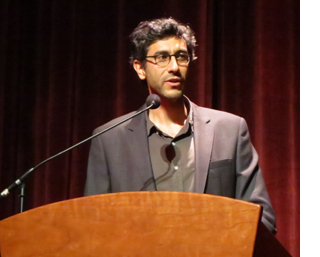 “Overlooked Film Festival” that April. (Roger’s Sundance review is here.) The film then played other festivals, notably Venice and our own Madison-based Wisconsin Film Festival. It won several awards, including an Independent Spirit Award for best first feature. In October Roger gave the film a more formal review, awarding it four stars. Man Push Cart never got a wide release, and it certainly didn’t make much money. Still, quite possibly the high profile provided by Roger’s attention allowed Bahrani to move ahead with his career.
“Overlooked Film Festival” that April. (Roger’s Sundance review is here.) The film then played other festivals, notably Venice and our own Madison-based Wisconsin Film Festival. It won several awards, including an Independent Spirit Award for best first feature. In October Roger gave the film a more formal review, awarding it four stars. Man Push Cart never got a wide release, and it certainly didn’t make much money. Still, quite possibly the high profile provided by Roger’s attention allowed Bahrani to move ahead with his career.
His second film, Chop Shop, brought him to Ebertfest a second time, in 2009. (Roger’s program notes are here, and his four-star review here.) At about that time, Bahrani’s third film, Goodbye Solo, was released. Given its modest budget, it did reasonably well at the box office, grossing nearly a million dollars worldwide (in contrast to Man Push Cart‘s roughly $56 thousand). Bahrani inched toward mainstream filmmaking with At Any Price (2012), starring Dennis Quaid and Zac Efron, and he is currently in post-production on 99 Homes, with Andrew Garfield, Michael Shannon, and Laura Dern. During the onstage discussion, he spoke of struggling to maintain a balance between the indie spirit of his earlier films and the more popularly oriented films he has recently made.
Bahrani visited Ebertfest for a third time this year, belatedly showing Goodbye Solo. We had enjoyed this film when it came out, and it holds up very well on a second viewing. It’s a simple story of opposites coming together by chance. An irrepressibly talkative, friendly immigrant cab driver, Solo (a nickname for Souléymane), becomes concerned when a dour elderly man engages him for a one-way trip to a regional park whose main feature is a windy cliff. He fears that William is planning suicide. Solo arranges to drive William whenever he calls for a cab and even becomes his roommate in a cheap hotel. Gradually, with the help of his young stepdaughter Alex, he seems to draw William out of his defensive shell.
As in Bahrani’s earlier films the main character is an immigrant and played by one, using his own first name (Souléymane Sy Savané). He’s the main character in that we are with him almost constantly, seeing William only as he does. William is a vital counterpart to him, however. He is perfectly embodied by Red West, an actor who worked for Elvis Presley and did stunt work and bit parts in films and television since the late 1950s. He may look vaguely familiar to some viewers, but he’s not really recognizable as a star and comes across convincingly as an aging man buffeted by life’s misfortunes.
Most of the film takes place in Winston-Salem, North Carolina, Bahrani’s hometown, with many moody, atmospheric shots of the cityscape at night. One crucial scene involves a drive into the woods and mountains, however, and much of it is filmed in a dense fog. One questioner from the audience asked if Bahrani had planned to shoot in such weather or if, given his short shooting schedule, the fog turned out to be a hindrance to him. He responded that he had dreamed of being able to shoot in fog and that the weather cooperated on the three days planned for that locale. In fact, he re-shot some images as the fog became denser, to keep the scene fairly consistent.
Bahrani’s presence at Ebertfest spans half its existence, from 2006 to 2014. As the festival becomes more diverse in its offerings, it is good to have him back as a reminder of the Ebertfest’s early emphasis on the “overlooked.”
Of Paramount importance
Logo for National Telefilm Associates, TV syndication arm of Republic Pictures.
DB here:
Among the guests at this year’s E-fest was Barry C. Allen. For over a decade Barry was Executive Director of Film Preservation and Archival Resources for Paramount. That meant that he had to find, protect, and preserve the film and television assets of the company—including not just the Paramount-labeled product but libraries that Paramount acquired. Most notable among the latter was the Republic Pictures collection.
We may think of Republic as primarily a B studio, but it produced several significant films in the 1940s and 1950s—The Red Pony, The Great Flammarion, Macbeth, Moonrise, and Johnny Guitar. John Wayne became the most famous Republic star in films like Dark Command, Angel and the Badman, and Sands of Iwo Jima. John Ford’s The Quiet Man was Wayne’s last for the studio, which folded in 1959. Next time you see one of the gorgeous prints or digital copies of that classic, thank Barry for his deep background work that underlies the ongoing work of his dedicated colleagues.
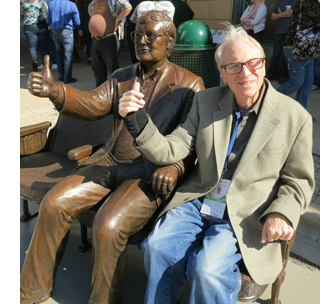 Barry told me quite a lot about conservation and restoration, but just as fascinating was his account of his earlier career. A lover of opera, literature, and painting since his teenage years, he was as well a passionate movie lover. An Indianapolis native, he thinks he saw his first movie in 1949 at the Vogue, now a nightclub. He projected films in his high school and explored still photography. He was impressed when a teacher told him: “If you want to make film, learn editing.” Soon he was in a local TV station editing syndicated movies.
Barry told me quite a lot about conservation and restoration, but just as fascinating was his account of his earlier career. A lover of opera, literature, and painting since his teenage years, he was as well a passionate movie lover. An Indianapolis native, he thinks he saw his first movie in 1949 at the Vogue, now a nightclub. He projected films in his high school and explored still photography. He was impressed when a teacher told him: “If you want to make film, learn editing.” Soon he was in a local TV station editing syndicated movies.
Hard as it may seem for young people today to believe, in the 1950s TV stations routinely cut the films they showed. Packages of 16mm prints circulated to local stations, and these showings were sponsored by local businesses. Commercials had to be inserted (usually eight per show), and the films had to be fitted to specific lengths.
WISH-TV ran three movies a day, and two of those would be trimmed to 90-minute air slots. That meant reducing the film, regardless of length, to 67-68 minutes. Barry’s job was to look for scenes to omit—usually the opening portions—and smoothly remove them. Fortunately for purists, the late movie, running at 11:30, was usually shown uncut, and then the station would sign off.
By coincidence I recently saw a TV print of Union Depot (Warners, 1932) that had several minutes of the opening exposition lopped off. We who have Turner Classic Movies don’t realize how lucky we are. Fortunately for film collectors, some stations, like Barry’s, retained the trims and put them back into the prints.
While working at WISH-TV, Barry began booking films part-time. He programmed some art cinemas in the Indianapolis area during the early 1970s, mixing classic fare (Marx Brothers), current cult movies (Night of the Living Dead), and arthouse releases like Discreet Charm of the Bourgeoisie—a bigger hit than anyone had anticipated. He also helped arrange a visit of Gloria Swanson with Queen Kelly; she carried the nitrate reels in her baggage.
At the same time, Barry was learning the new world of video editing, with ¾” tape and telecine. Because of his experience in television, Barry was contacted by Paramount to become Director of Domestic Syndication Operations. His chief duty was to deliver films to TV stations via tape, satellite, and prints. From that position, he moved to the preservation role he held until 2010, when he retired.
Barry is a true film fan. He has reread Brownlow’s The Parade’s Gone By many times and retains his love for classic cinema. The film that converted him to foreign-language cinema was, as for many of his generation, Children of Paradise, but he retains a fondness for Juliet of the Spirits, The Lady Killers, and other mainstays of the arthouse circuit of his (and my) day. He’s proudest of his work preserving John Wayne’s pre-Stagecoach films.
It was a great pleasure to hang out with Barry at Ebertfest. Talking with him reminded me that The Industry has long housed many sophisticated intellectuals and cinephiles. Not every suit is a crass bureaucrat.
Young-ish adult
Patton Oswalt had planned to come to Ebertfest in an earlier year, to accompany Big Fan and to show Kind Hearts and Coronets to an undergrad audience. He had to withdraw, but he showed up this year. On Wednesday night he screened The Taking of Pelham 123 to an enthusiastic campus crowd, and the following night, after getting his Golden Thumb, he talked about Young Adult. (Roger’s review is here.)
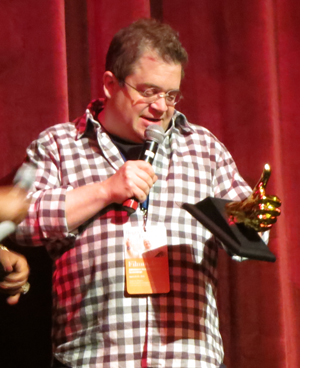 As you might expect from someone who has mastered stand-up, writing (the excellent Zombie Spaceship Wasteland), TV acting, and film acting, Oswalt stressed the need for young people to grab every opportunity to work. He enjoys doing stand-up; with no need to adjust to anybody else, it’s “the last fascist post in entertainment.” But he also likes working with other actors in the collaborative milieu of shooting film. He insists on not improvising: “Do all the work before you get on camera.” I was surprised at how quickly Young Adult was shot—one month, no sets. Oswalt explained that one aspect of his character in the film, a guy who customizes peculiar action figures, was based on Sillof, a hobbyist who does the same thing and sells the results. Oswalt talks about Sillof and Roger Ebert here.
As you might expect from someone who has mastered stand-up, writing (the excellent Zombie Spaceship Wasteland), TV acting, and film acting, Oswalt stressed the need for young people to grab every opportunity to work. He enjoys doing stand-up; with no need to adjust to anybody else, it’s “the last fascist post in entertainment.” But he also likes working with other actors in the collaborative milieu of shooting film. He insists on not improvising: “Do all the work before you get on camera.” I was surprised at how quickly Young Adult was shot—one month, no sets. Oswalt explained that one aspect of his character in the film, a guy who customizes peculiar action figures, was based on Sillof, a hobbyist who does the same thing and sells the results. Oswalt talks about Sillof and Roger Ebert here.
It’s common for viewers to notice that Mavis Gary, the malevolent, disturbed main character of Young Adult, doesn’t change or learn. “Anti-arc and anti-growth,” Oswalt called the movie. I found the film intriguing because structurally, it seems to be that rare romantic comedy centered on the antagonist.
Mavis returns to her home town to seduce her old boyfriend, who’s now a happy husband and father. A more conventional plot would be organized around Buddy and his family. In that version we’d share their perspective on the action and we’d see Mavis as a disruptive force menacing their happiness.
What screenwriter Diablo Cody has done, I think, is built the film around what most plots would consider the villain. So it’s not surprising that there’s no change; villains often persist in their wickedness to the point of death. Attaching our viewpoint to the traditional antagonist not only creates new comic possibilities, mostly based on Mavis’s growing desperation and her obliviousness to her social gaffes. The movie comes off as more sour and outrageous than it would if Buddy and Beth had been the center of the plot.
Making us side with the villain also allows Oswalt, as Matt Freehauf, to play a more active role as Mavis’s counselor. In a more traditional film, he’d probably be rewritten to be a friend of Buddy’s. Here he’s the wisecracking voice of sanity, reminding Mavis of her selfishness while still being enough in thrall to high-school values to find her fascinating. As in Shakespearean comedy, though, the spoiler is expelled from the green world that she threatens. It’s just that here, we go in and out of it with her and see that her illusions remain intact. Maybe we also share her sense that the good people can be fairly boring.
All you can eat
There aren’t any villains in Ann Hui’s A Simple Life, a film we first saw in Vancouver back in 2011. Roger had hoped to bring it last year, but Ann couldn’t come, as she was working on her upcoming release, The Golden Era. This year she was free to accompany the film that had a special meaning for Roger at that point in his life.
The quietness of the film is exemplary. It’s an effort to make a drama out of everyday happenings—people working, eating, sharing a home, getting sick, worrying about money, helping friends, and all the other stuff that fills most of our time. The two central characters are, as Roger’s review puts it, “two inward people” who are simple and decent. Yet Ann’s script and direction, and the playing of Deanie Yip Tak-han and Andy Lau Tak-wah, give us a full-length portrait of a relationship in which each depends on the other.
Roger Leung takes Ah-Tao, his amah, or all-purpose servant, pretty much for granted. She feeds him, watches out for his health, cleans the apartment, even packs for his business trips. When he’s not loping to and from his film shoot, he’s impassively chowing down her cooking and staring at the TV. A sudden stroke incapacitates her, and now comes the first surprise. A conventional plot would show her resisting being sent to a nursing home, but she insists on going. Having worked for Roger’s family for sixty years, Ah-Tao can’t accept being waited upon in the apartment. So she moves to a home, where most of the film takes place.
A Simple Life resists the chance to play up dramas in the facility. Thanks to a mixture of amateur actors and non-actors, the film has a documentary quality. It captures in a matter-of-fact way the grim side of the place—slack jaws, staring eyes, pervasive smells. (A small touch: Ah-Tao stuffs tissue into her nostrils when she heads to the toilet.) Mostly, however, we get a sense of the facility’s everyday routines as the seasons change. The dramas are minuscule. Occasionally the old folks snap at one another, and one visitor gets testy with her mother-in-law. One woman dies (in a bit of cinematic trickery, Ann suggests that it’s Ah-Tao), and an old man who keeps borrowing money is revealed to have a bit of a secret. It’s suggested that a pleasant young woman working at the care facility will become Roger’s new amah, but that seems not to happen. The prospect of a romance with her is evoked only to be dispelled.
Ah-Tao’s health crisis has made Roger more self-reliant, but his life has become much emptier. He seems to realize this in a late scene, when he stands in the hospital deciding how to handle Ah-Tao’s final illness. Throughout the film, food has been a multifaceted image of caring, community, friendship, childhood (Roger’s friends recall Ah-Tao cooking for them), and even the afterlife. Ah-Tao and Roger rewrite the Ecclesiastes line about what’s proper to every season by filling in favorite dishes. As he mulls over Ah-Tao’s fate, Roger is, of course, eating. But it’s cheap takeaway noodles and soda pop. This silent scene measures his, and her, loss better than any dialogue could.
The art of American agitprop
Matt Zoller Seitz and Oliver Stone on stage at the Virginia Theatre.
A Simple Life is a very quiet film. Ebertfest’s highest-profile visitors brought along two of the noisiest movies of 1989. It’s the twenty-fifth anniversary of Do The Right Thing (Roger’s review) and Born on the Fourth of July (Roger’s review), and seen in successive nights they seemed to me to put the “agitation” into agitprop.
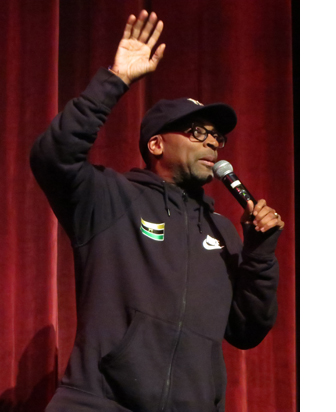 During the Q & A, Spike Lee reminded us that some initial reviews of the film (here shown in a gorgeous 35mm print) had warned that the film could arouse racial tensions. Odie Henderson has charted the alarmist tone of many critiques. Lee insisted, as he has for years, that he was asking questions rather than positing solutions. “We wanted the audience to determine who did the right thing.” He added that the film was, at least, true to the tensions of New York at the time, which were–and still are–unresolved.
During the Q & A, Spike Lee reminded us that some initial reviews of the film (here shown in a gorgeous 35mm print) had warned that the film could arouse racial tensions. Odie Henderson has charted the alarmist tone of many critiques. Lee insisted, as he has for years, that he was asking questions rather than positing solutions. “We wanted the audience to determine who did the right thing.” He added that the film was, at least, true to the tensions of New York at the time, which were–and still are–unresolved.
The ending has become the most controversial part of the film. It’s here that Lee was, I think, especially forceful. The crowd in the street is aghast at the killing of Radio Raheem by a ferocious cop, but what really triggers the riot is Mookie’s act of smashing the pizzeria window. I’ve always taken this as Mookie finally choosing sides. He has sat the fence throughout–befriending one of Sal’s sons and quarreling with the other, supporting Sal in some moments but ragging him in others. Now he focuses the issue: Are property rights (Sal’s sovereignty over his business) more important than human life? Moreover, in a crisis, Mookie must ally himself with the people he lives with, not the Italian-Americans who drive in every day. It’s a courageous scene because it risks making viewers, especially white viewers, turn against that charming character, but I can’t imagine the action concluding any other way. Lee had to move the project to Universal from Paramount, where the suits wanted Mookie and Sal to hug at the end.
Staking so much on social allegory, the film sacrifices characterization. Characters tend to stand for social roles and attitudes rather than stand on their own as individuals. The actors’ performances, especially their line readings, keep the roles fresh, though, and the film still looks magnificent. I was struck this time by the extravagance of its visual style. In almost every scene Lee tweaks things pictorially through angles, color saturation, slow-motion, short and long lenses, and the like–extravagant noodlings that may be the filmic equivalent of street graffiti.
By the end, in order to underscore the confrontation of Radio Raheem and Sal, Lee and DP Ernest Dickerson go all out with clashing, steeply canted wide-angle shots. (We’ve seen a few before, but not so many together and usually not so close.) Having dialed things up pretty far, the movie has to go to 10.
In Born on the Fourth of July, Stone more or less starts at 11 and dials up from there. Beginning with boys playing soldier and shifting to an Independence Day parade that for scale and pomp would do justice to V-J Day, the movie announces itself as larger than life. The storyline is pretty straightforward, much simpler than that of Do The Right Thing. A keen young patriot fired up with JFK’s anti-Communist fervor plunges into the savage inferno of Viet Nam. Coming back haunted and paralyzed, Ron Kovic is still a fervent America-firster until he sees college kids pounded by cops during a demonstration. This sets him thinking, and eventually, after finding no solace in the fleshpots of Mexico, he returns to join the anti-war movement.
Even more than Lee, Stone sacrifices characterization and plot density to a larger message. The Kovic character arc suits Cruise, who built his early career on playing overconfident striplings who get whacked by reality. But again characterization is played down in favor of symbolic typicality. While there’s a suggestion that Ron Kovic joins the Marines partly to prove his manhood after losing a crucial wrestling match, the plot also insists that his hectoring mother and community pressure force him to live up to the model of patriotic young America. He becomes an emblem of every young man who went to prove his loyalty to Mom and apple pie.
Likewise, Ron’s almost-girlfriend in high school becomes a college activist and so their reunion–and her indifference to his concern for her–is subsumed to a larger political point. (The hippies forget the vets.) We learn almost nothing about the friend who also goes into service; when they reunite back home, their exchanges consist mostly of more reflections on the awfulness of the war. Later Cruise is betrayed, almost casually, by an activist who turns out to be a narc. But this man is scarcely identified, let alone given motives: he’s there to remind us that the cops planted moles among the movement.
What fills in for characterization is spectacle. I don’t mean vast action; Stone explained that he had quite a limited budget, and crowds were at a premium. Instead, what’s showcased, as in Do The Right Thing, is a dazzling cinematic technique.
Visiting the UW-Madison campus just before coming to Urbana for Ebertfest, Stone offered some filmmaking advice: “Tell it fast, tell it excitingly.” The excitement here comes from slamming whip pans, thunderous sound, various degrees of slow-motion, silhouettes, jerky cuts, Steadicam trailing, handheld shots, all jammed into the wide, wide frame. Every crack is filled with icons and noises–flags, whirring choppers, kids with toy guns, prancing blondes, commentative music. “Soldier Boy” plays on the supermarket Muzak when Ron is telling Donna about his plans.
By the time Ron visits the family of the comrade he accidentally killed, Stone finds another method of visual italicization: the split-focus diopter that creates slightly surreal depth.
Since so many scenes have consisted of a flurry of intensified techniques, simple over-the-shoulder reverse shots might let the excitement level drop. So a new optical device aims to deliver fresh impact in one of the film’s quietest moments.
Like Lee, Stone took the Virginia Theatre audience behind the scenes. He agreed with William Friedkin, who was originally slated to do the film: “This is as close as you’ll every come to Frank Capra.” Instead of using the shuffled time scheme of Kovic’s autobiography, Friedkin advised that “This is good corn. Write it straight through.” Hence the film breaks into distinct chapters, each about half an hour long and sometimes tagged with dates. They operate as blocks measuring phases of Ron’s conversion. Like many filmmakers of his period, Stone deliberately made each chapter pictorially distinct–the low-contrast Life-magazine colors of the opening parade versus the lava-like orange of the beachfront battle.
Stone pointed out that this film marked the beginning of his career as a figure of public controversy. Like Lee, he was attacked from many sides, and from then on he was a lightning rod. Matt Zoller Seitz (who’s preparing a book on Stone) pointed out that at the period, he was astonishingly prolific. From 1986 (Salvador, Platoon) to 1999 (Any Given Sunday), he directed twelve features, about one a year.
Lee was hyperactive as well over the same years, releasing fourteen films. And neither has stopped. Lee’s new film is the Kickstarter-funded Da Sweet Blood of Jesus, while Stone is touring to support the DVD release of his 2012 documentary series, The Untold History of the United States. Both men like to work, and more important, they’re driven by their ideas as well as their feelings. By seeking new ways to agitate us, they impart an inflammatory energy to everything they try. And in giving them a chance to share their insights and intelligence with audiences outside the Cannes-Berlin-Venice circuit, Ebertfest once again demonstrates its uniqueness. Roger would be proud.
The introductions and Q&A sessions for most of the films, as well as the morning panel discussions, have been posted on Ebertfest’s YouTube page. Program notes for each film are online; see this schedule and click on the title.
For historical background on Barry Allen’s work as an editor of syndicated TV prints, see Eric Hoyt’s new book Hollywood Vault: Film Libraries Before Home Video.
P. S. 1 May 2014: Thanks to Ramin S. Khanjani for pointing out that Ramin Bahrani had worked on other films before Man Push Cart. These included one feature he made in Iran, Biganegan (Strangers, 2000); it got only limited play in festivals and apparently a few theaters. I can’t find information about the others online, and presumably they were shorts and/or did not receive distribution. (K.T.)
Ann Hui, with Kristin, gets into the spirit of Ebertfest. David is represented in absentia by the Dots.
How to tell a movie story: Mr. Stahr will see you now
DB here:
It is 1935. Mr. George Boxley is a prominent writer who has been brought to Hollywood. He is working with two other screenwriters on a story, but he feels angry and dissatisfied. His collaborators ruin his contributions, and when he writes solo he produces “interesting talk but nothing more.” He has come to the head of production to complain, and beneath his annoyance lies a mild contempt for the movie craft.
He has tried to adjust his standards to movies, he explains, by having his dialogue delivered while his characters are dueling. At the end of the scene one falls into a well and has to be hauled up again.
The studio chief, Monroe Stahr, asks if Mr. Boxley would include such a scene in a book of his own.
“Naturally not.”
“You’d consider it too cheap.”
Boxley replies: “Movie standards are different.”
“Do you ever go to them?” Stahr asks.
“No,” confesses the parvenu screenwriter. “Almost never.” He explains, defensively, that movies are full of things like duels and falling down wells “and wearing strained facial expressions and talking incredible and unnatural dialogue.”
“Skip the dialogue for a minute,” said Stahr. “Granted your dialogue is more graceful than what these hacks can write—that’s why we brought you out here. But let’s imagine something that isn’t either bad dialogue or jumping down a well. Has your office got a stove in it that lights with a match?”
“I think it has,” said Boxley stiffly, “—but I never use it.”
Mr. Boxley is about to get a tutorial in how to tell a movie story.
Behind the glitter
F. Scott Fitzgerald
There have been novels about Hollywood as long as the movie industry has been there. Most have been either straightforward wish-fulfillment (girl/boy from the sticks makes it big) or cautionary tales (boy/girl fails or becomes depraved). The more ambitious “Hollywood novel” has been more sour and sweeping. It presents itself as a harsh exposé that makes a broad social comment on picture-makers, their public, and the society that spawns both.
This serious Hollywood novel is largely a creature of the late 1930s. Wedding hard-boiled style to Depression-era realism, Nathanael West’s Day of the Locust (1938) and Horace McCoy’s I Should Have Stayed Home (1938) present stark, aggressively despairing accounts. In these books, Hollywood is America, only more so.
Both West’s and McCoy’s books fared poorly in the market. The triumph was Budd Schulberg’s What Makes Sammy Run? (1941), which found in the rapacious Sammy Glick a prototype of the modern entertainment entrepreneur. Schulberg daringly emphasized the fact that Sammy was a Jew, creating a controversy that lasted for quite a while.
The booming movie market of the war years, along with the fact that more novelists found themselves involved with the studios, made the 1940s something of a golden age of the Hollywood novel. The movie kingdom became the setting for dozens of murder mysteries, veiled memoirs, and satires—some written by practicing screenwriters. (Among the most notable: Ben Hecht’s offhand but heartfelt I Hate Actors!, 1944). At a higher level of literary prestige, there were two 1948 titles from Englishmen, Evelyn Waugh’s caustic The Loved One and Aldous Huxley’s Ape and Essence, a novel written as a pseudo-screenplay. But none of these finished works won the enduring fame of an incomplete story published in the same year that Schulberg introduced Sammy Glick.
Built on the grand scale
Irving Thalberg.
In 1939 F. Scott Fitzgerald had begun The Last Tycoon (perhaps intending to call it The Love of the Last Tycoon: A Western). By then his brief screenwriting career was over, but he was fascinated by MGM’s boy wonder Irving Thalberg, “one of the half-dozen men I have known who were built on the grand scale.” Fitzgerald decided to center his plot on Monroe Stahr, a Thalberg-like producer.
Stahr is a shrewd, intellectually gifted workaholic who is an expert in manipulating what is coming to be a new system of moviemaking. Brisk and efficient in the office, Stahr is occasionally cold and arrogant, but his primary trait is a remarkable sensitivity to the emotional temperature of each situation. He gains our sympathy because in private Stahr is sunk in melancholy, longing for his dead wife and hoping to find another woman to love.
When Fitzgerald died in 1940, he had completed less than half of The Last Tycoon. His long-time friend, the critic Edmund Wilson, assembled an edition that was issued in 1941, with the finished portions supplemented by notes and a five-act outline. The book had a great impact. The New York Times reviewer commented:
Uncompleted though it is, one would be blind indeed not to see that it would have been Fitzgerald’s best novel and a very fine one. Even in this truncated form it not only makes absorbing reading; it is the best piece of creative writing that we have about one phase of American life—Hollywood and the movies.
Matthew J. Bruccoli, who has brought out the authoritative edition, remarks:
Even in its preliminary and incomplete condition, The Love of the Last Tycoon is regarded as the best novel written about the movies.
Reading the book for my research on the 1940s, I became fascinated by its understanding of what we might call the Hollywood aesthetic.
That understanding begins with a recognition of the production process. Most Hollywood novels mention actual stars and directors, but The Last Tycoon goes beyond name-dropping. It takes us into the offices, the editing rooms, and onto the set when Stahr must fire a director. These scenes have an authority that most novels lack, assisted by Fitzgerald’s effort to present his mogul not as a monster but as a man of genuine, if sometimes dictatorial, charm, tact, and taste.
Setting his novel in 1935, Fitzgerald also registers how studio organization shifted toward a central-producer system. Stahr deliberately avoids learning the details of camerawork, editing, and sound.
He could have understood easily enough—often he preferred not to, to preserve a sensual acceptance when he saw the scene unfold in the rushes. . . . His function was different from that of Griffith in the early days, who had been all things to every finished frame of film.
One of Fitzgerald’s most cryptic notes indicates his recognition of different studio styles.
The Warner Brothers narrative writing and the Metro dramatic, packed—cut back and forth writing from Stahr.
This might be a reference to Warners’ vivacious montage sequences, which were sometimes considered “narrative,” while fully enacted scenes were called “dramatic.” The use of “cut back and forth” here exemplifies Fitzgerald’s occasional use of movie slang in his notes, as when he gets his characters on the Super Chief passenger train:
In a very short transition or montage, I bring the whole party West on the chief.
Like many intellectuals of his time, Fitzgerald was fascinated by the movies as an artistic medium. The standard version of film history was articulated in many books of the period, most notably Lewis Jacobs’ Rise of the American Film (1938). Fitzgerald dots his novel with commonplaces about the history of cinema.
She was reputed to have been on the set the day Griffith invented the close-up!
[Stahr] prepared for the meeting [with the Writers Guild] by running off the Russian Revolutionary Films that he had in his film library at home. He also ran off “Doctor Caligari” and Salvador Dali’s “Un Chien Andalou,” possibly suspecting that they had a bearing on the matter.
Astonishingly, Fitzgerald even considered calling his novel The Lumière Man.
Most original, I think, is the episode I’ve started to present to you. It’s an exemplary scene, showing how good Stahr is at his job. He subtly steers Mr. Boxley, the East Coast littérateur, toward returning to the screenplay. But he also tutors Mr. Boxley, and us, in a deeper awareness of how classical Hollywood aimed to tell its stories.
Just making pictures
Imagine, Stahr tells Boxley, you’re sitting in your office, tired out.
A pretty stenographer that you’ve seen before comes into the room and you watch her—idly. She doesn’t see you although you’re very close to her. She takes off her gloves, opens her purse, and dumps it out on the table.
Stahr continues. From her change, the young woman picks out a nickel and puts it on the desk. She picks up a matchbox and then takes her black gloves to the stove. She puts them inside the stove and starts to light it, when the phone suddenly rings.
The girl picks it up, says hello—listens—and says deliberately into the phone, “I’ve never owned a pair of black gloves in my life.”
The stenographer hangs up and kneels by the stove again.
Just as she lights the match you glance around very suddenly and see that there’s another man in the office, watching every move the girl makes.
Stahr pauses.
“Go on,” said Boxley smiling. “What happens?”
“I don’t know,” said Stahr. “I was just making pictures.”
Boxley feels he’s been wrong-footed.
“It’s just melodrama,” he said.
“Not necessarily,” said Stahr. “In any case nobody has moved violently or talked cheap dialogue or had any facial expression at all. There was only one bad line, and a writer like you could improve it. But you were interested.”
Question time
Throughout the 1930s, critics like Otis Ferguson praised American studio pictures for their clean, straight storytelling. The primary concern of Fritz Lang, for instance, “is with the rightness and immediacy of each fragment as it appears to you, makes its impression, leads you along with each incident of the story, and projects the imagination beyond into things to come.” I think that Stahr’s tutorial helps us understand how that blend of immediacy and flow, vivid moments and keen anticipation, works.
For one thing, the gloves scene doesn’t fit certain clichés about Hollywood. It isn’t spectacular; it’s not a chase or a fight or a seduction or a slapstick episode. As Stahr points out, nobody is dueling or falling down a well.
We often say that Hollywood movies emphasize plot (lots of action) over character (stereotyped, at that). But this scene doesn’t have much action, and we don’t know anything about the character. (We can’t even be sure she’s lying; maybe these gloves aren’t hers.) What we have is plot and character fused in a situation. The scene creates, out of mundane materials, a crisis.
We say that Hollywood films grab us through emotion. Do we feel strong passions here? Well, not so much. We say that Hollywood films make us identify with the characters. Are we identifying with the young woman, or the magically unseen Boxley, or the man suddenly revealed watching the whole thing? Not really. The paramount emotion, as Stahr points out, is that diffuse, low-level one we call interest.
What does grab us, I think you’ll agree, are the questions that are implicit in the action. Why does the woman leave a nickel on the desk? Why does she start to burn the gloves? Why does she deny owning black gloves? Why is the man watching her? And what will happen next?
Noël Carroll has developed a theory of narrative he calls “erotetic.” Telling a story, he suggests, creates a controlled cascade of questions. Sometimes they pile up, as here; sometimes a question is answered but the answer raises another question. Stahr’s lesson supports Carroll’s idea that in any art, narration is a matter of asking, postponing, and answering questions. Erotetic principles, Stahr suggests, are more central to Hollywood storytelling than obvious appeals like spectacle and gags.
Another narrative theorist, Meir Sternberg, has proposed that the “master effects” aroused by stories are curiosity, surprise, and suspense. Curiosity is a matter of wondering about what led up to the actions we’re seeing now. What has impelled our stenographer to burn these gloves? Surprise comes from revealing a gap in the telling’s continuity. This occurs when Stahr’s “pan shot” (“you glance around very suddenly”) reveals a man in the office watching her efforts. If curiosity involves the past, and surprise punctuates the present, suspense points us forward: What will happen next? Stahr’s anecdote breaks off just as we learn that the man is watching. Will he prevent her from burning the gloves? More generally, how will he figure in the plot to come? Sternberg’s three cognitive attitudes, which he considers fundamental to narrative engagement, are neatly wrapped up in Stahr’s toy example.
Every writer knows that coming up with a grabby scene is easy. The problem is paying everything off. So admittedly, Stahr has dodged the work of figuring out the whole plot. Nonetheless, his example should clarify one notion of Hollywood storytelling. Relatively easy to shoot (Mr. Boxley, close to the woman but mysteriously unseen, is obviously the camera), but demanding skill in pacing and performance, the scene shows, I think, the unpretentious power of that clean storytelling that Ferguson and his peers celebrated.
The intellectuals who throughout the 1930s and 1940s derided Hollywood as simple-minded and uncreative didn’t really drill down into the specifics of how the storytelling system worked. Fitzgerald did, perhaps because as a novelist he could observe and appreciate the craft of it—even if he couldn’t actually succeed at it himself. The Last Tycoon is a nuanced tribute to Hollywood as an aggressive business that need not necessarily suffocate richness of personality. It’s also a modest tribute to the power of a storytelling model that is only apparently obvious.
“What was the nickel for?” asked Boxley evasively.
“I don’t know,” said Stahr. Suddenly he laughed. “Oh yes—the nickel was for the movies.”
I’ve drawn my quotations of Fitzgerald’s working drafts from both Edmund Wilson’s 1941 edition of The Last Tycoon and from Matthew J. Bruccoli’s 1993 edition of The Love of the Last Tycoon: The Authorized Text. Each version contains many intriguing jottings that aren’t included in the other one. Quotations from the main text come from Bruccoli’s edition, except that I’ve corrected Fitzgerald’s misspelling of “nickel.”
I’ve been guided by Anthony Slide’s excellent bibliographical survey, The Hollywood Novel: A Critical Guide to Over 1200 Works (McFarland, 1995). See also Budd Wilson Schuberg’s portmanteau review, “Literature of the Film: The Hollywood Novel,” Films 1, 2 (Spring 1940), 68-78.
Janet Staiger explains how Thalberg, a prototype of the central-producer system during the 1920s, was gradually embracing the newer division of labor, that of the producer-unit system, in the early 1930s. See her chapter 25 in the book she wrote with Kristin and me, The Classical Hollywood System: Film Style and Mode of Production to 1960.
Noël Carroll’s theory of erotetic narration is explained in several of his publications; a convenient one is The Philosophy of Horror, chapter 3. For Meir Sternberg’s account of curiosity, suspense, and surprise, see his “Telling in Time” series in Poetics Today (Winter 1990, Fall 1992, and Spring 2006).
J. Donald Adams’ review of The Last Tycoon is in The New York Times (9 November 1941). My quotation from Otis Ferguson comes from “Fritz Lang and Company,” The Film Criticism of Otis Ferguson, ed. Robert Wilson (Temple University Press, 1971), 372.
An earlier entry on Ferguson further develops his ideas about the clean contours of Hollywood storytelling.
Elia Kazan’s film of The Last Tycoon includes the Boxley scene. Apart from adding unnecessary lines, it’s an exercise in ham, with other characters watching Boxley’s discomfiture and a smug Stahr (Robert De Niro) dashing about the room and pantomiming the action. Kazan’s Stahr burlesques the story situation he invokes, whereas I take the novel’s scene as a playful but sincere object lesson.
Stahr shows Boxley the black gloves in Kazan’s Last Tycoon.












